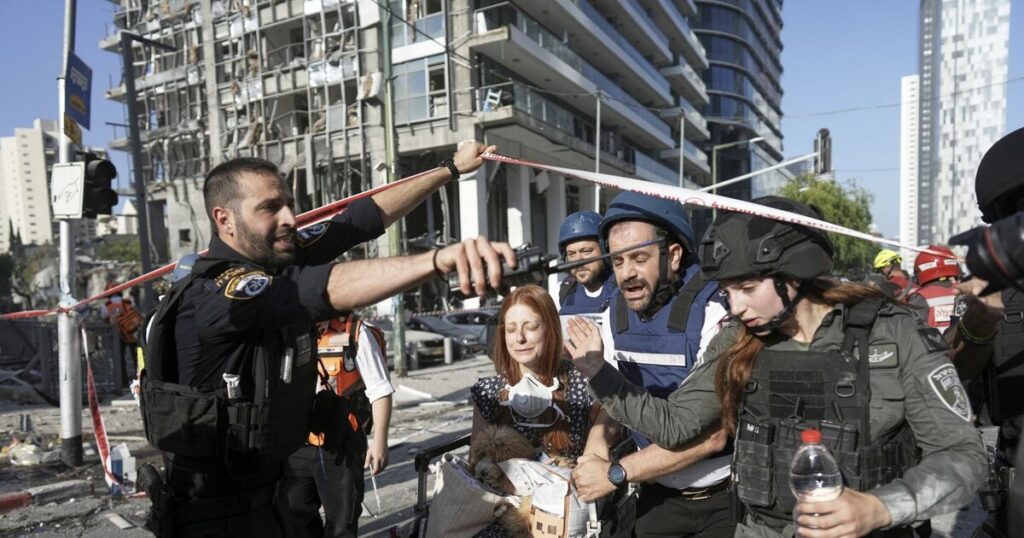An Iranian missile struck the main hospital in southern Israel early Thursday, causing injuries and “extensive damage”, according to officials.
Separate Iranian strikes targeted a high-rise apartment building in Tel Aviv and other locations in central Israel. Israel’s Magen David Adom rescue service reported at least 40 people injured.
In response, Israel conducted strikes on Iran’s Arak heavy water reactor, marking its most recent assault on Iran’s extensive nuclear program. This occurred on the seventh day of the conflict, which began with a surprise wave of Israeli airstrikes targeting Iranian military sites, high-ranking officers, and nuclear scientists.
Iran has launched hundreds of missiles and drones at Israel, but the majority have been intercepted by Israel’s multi-layered air defense system, which detects and destroys incoming projectiles aimed at populated areas and vital infrastructure.
One missile impacted the Soroka Medical Centre, a facility with over 1,000 beds serving approximately one million residents in southern Israel.
A hospital statement indicated that several parts of the centre were damaged and that the emergency room was treating patients with minor injuries. The hospital is currently closed to new patients except for life-threatening emergencies.
Over the past week, many Israeli hospitals have enacted emergency protocols, converting underground parking areas into hospital wards and relocating patients, particularly those on ventilators or requiring intensive care, underground.
Meanwhile, Iranian state TV reported the attack on the Arak site, claiming that there was “no radiation danger whatsoever”.
An Iranian state television reporter, broadcasting live from the nearby town of Khondab, stated that the facility had been evacuated and there was no damage to civilian areas surrounding the reactor.
Israel had issued warnings earlier on Thursday that it would target the facility and urged the public to evacuate the area.
The Israeli military stated that Thursday’s round of airstrikes targeted Tehran and other regions of Iran, but did not provide further details.
The strikes followed a day after Iran’s supreme leader rejected US calls for surrender and warned that any American military involvement would inflict “irreparable damage” on the United States.
Israel’s campaign has already targeted Iran’s enrichment site at Natanz, centrifuge workshops in the Tehran area, and a nuclear site in Isfahan. The strikes have also resulted in the deaths of high-ranking generals and nuclear scientists.
A Washington-based Iranian human rights group reported that at least 639 people, including 263 civilians, had been killed in Iran, with over 1,300 wounded.
In retaliation, Iran has launched approximately 400 missiles and hundreds of drones, resulting in at least 24 deaths in Israel and hundreds of injuries.
The Arak heavy water reactor is located 155 miles southwest of Tehran.
Heavy water is used to cool nuclear reactors, but produces plutonium as a byproduct, which has the potential to be used in nuclear weapons.
This would provide Iran with an alternate route to developing a nuclear weapon, beyond enriched uranium, should they choose to pursue that path.
Under the 2015 nuclear deal with world powers, Iran agreed to redesign the facility to address proliferation concerns.
In 2019, Iran initiated the operation of the heavy water reactor’s secondary circuit, which, at the time, did not violate the terms of Tehran’s 2015 nuclear agreement with world powers.
The UK was assisting Iran in redesigning the Arak reactor to limit the amount of plutonium produced, taking over from the US, which withdrew from the project following President Donald Trump’s 2018 decision to unilaterally withdraw America from the nuclear deal.
The International Atomic Energy Agency (IAEA), the United Nations’ nuclear watchdog, has been urging Israel not to attack Iranian nuclear sites. IAEA inspectors are reported to have last visited Arak on May 14.
Due to restrictions imposed by Iran on inspectors, the IAEA has stated that it has lost “continuity of knowledge” regarding Iran’s heavy water production, meaning it cannot fully verify Tehran’s production and stockpile.


